Uncertainty Evaluation in Vision-Based Techniques for the Surface Analysis of Composite Material Components
Abstract
:1. Introduction
2. Materials and Methods
- Surface characteristics of material (texture and optical characteristics);
- Surface curvature and geometry;
- Measurement set-up (lighting and distance of measurement);
- Choice of the parameters of the algorithm for image analysis (depending on the method).
2.1. Surface Characteristics of Material (Texture and Optical Characteristics)
2.2. System Calibration and Surface Curvature and Geometry
2.3. Measurement Set-Up
2.4. Yarn Angle Measurement Methods and Parameters of Interest
- Measurements on a flat plate whose nominal angles are 90°:
- 32 repeated measurements, realized with reference to the same couple of yarns. In particular, the pair was taken at random within an area of 200 × 200 mm2, and repeated measurements were carried out by redefining the ROIs for the identification of the edges each time;
- 32 measurements on different couples of yarns, taken within the considered area of 200 × 200 mm2. Couples were considered different if at least one element of the pair was different. It was determined that the area considered was of the same extent as the flat sheet from which the semi-spherical object was obtained by thermoforming.
- Measurement on the semi-spherical object. The semi-spherical surface was divided into 16 segments and 3 zones (central, intermediate and extreme), as indicated in the scheme of Figure 6.
3. Results
3.1. Measurements on the Flat Plate
3.2. Measurements on 3D Objects
3.3. Uncertainty Evaluation
- Image resolution is related to the camera sensor resolution and the distance from the workpiece. It can be estimated, as indicated in Figure 13, with reference to the horizontal direction, but the same considerations can be made for the vertical direction. The number of pixels in the horizontal direction, shown in Figure 13, corresponds to the length of the identified ROI for the angle measurement.The most unfavorable combinations of angle variations in vertical and horizontal directions were considered, and the results are indicated as variability in the uncertainty budget in Table 1. The contributions were different for TRICAP and TEPEX, because the elements considered for the measurements were of different lengths in the two types of materials: in the former they were longer, because the entire bundle of fibers was visible; in the second, they were partially submerged in the black matrix.
- The variability of the method was evaluated in the repeatability trials on the same couple of elements, with reference to TRICAP and TEPEX materials. The results, in terms of standard deviation (already discussed in Section 3.1), are reported in Table 1;
- The variability of the measurand was evaluated on the basis of the measurement results obtained on the same couple and different couples of elements.
- Parameter set-up: a sensitivity analysis of the main parameters of the processing algorithms was carried out, and a maximum variation of 1.5° was obtained for the angle measurement in the case of TRICAP; a maximum variation of 1° was found for TEPEX. The different variability was due to the fact that in the case of TRICAP, where the matrix was transparent and the surface appeared rather uniform, it was more difficult to determine the edges necessary for measuring the angles, and variations in the threshold settings had a greater influence on the results;
- Illumination: lighting conditions were varied, modifying the number of illuminators (one or two), and distances in the range 500–1500 mm with respect to the piece, keeping the other parameters constant, and the maximum variation of the angle measurement was evaluated in the two examined cases.
4. Discussion
5. Conclusions
Author Contributions
Funding
Institutional Review Board Statement
Informed Consent Statement
Data Availability Statement
Conflicts of Interest
References
- Di Ilio, A.; Di Genova, L.G.; Stamopoulos, A.G. Implementation of the modified V-Notched Rail Shear method for characterizing glass fiber thermoplastic composites at sub-zero and elevated temperatures. Polym. Test. 2021, 93, 106174. [Google Scholar] [CrossRef]
- Bardl, G.; Nocke, A.; Hübner, M.; Gereke, T.; Pooch, M.; Schulze, M.; Heuer, H.; Schiller, M.; Kupke, R.; Klein, M.; et al. Analysis of the 3D draping behavior of carbon fiber non-crimp fabrics with eddy current technique. Compos. Part B Eng. 2018, 132, 49–60. [Google Scholar] [CrossRef]
- Şerban, A. Automatic detection of fiber orientation on CF/PPS composite materials with 5-harness satin weave. Fiber. Polym. 2016, 17, 1925–1933. [Google Scholar] [CrossRef]
- Zheng, T.; Guo, L.; Shun, R.; Li, Z.; Zhu, H. Investigation on the compressive damage mechanisms of 3D woven composites considering stochastic fiber initial misalignment. Compos. Part A Appl. Sci. 2021, 143, 106295. [Google Scholar] [CrossRef]
- Di Ilio, A.; Stamopoulos, A.G. On the predictive tools for assessing the effect of manufacturing defects on the mechanical properties of composite materials. Procedia CIRP 2019, 79, 563–567. [Google Scholar] [CrossRef]
- Stamopoulos, A.; Di Ilio, A. Numerical and experimental analysis of the thermoforming process parameters of semi-spherical glass fiber thermoplastic parts. Procedia CIRP 2021, 99, 420–425. [Google Scholar] [CrossRef]
- Haanappel, S.P.; Ten Thije, R.H.W.; Sachs, U.; Rietman, B.; Akkerman, R. Formability analyses of uni-directional and textile reinforced thermoplastics. Compos. Part A Appl. Sci. 2014, 56, 80–92. [Google Scholar] [CrossRef]
- Zhang, H.; Chen, J.; Yang, D. Fiber misalignment and breakage in 3D printing of continuous carbon fiber reinforced thermoplastic composites. Addit. Manuf. 2021, 38, 10177. [Google Scholar] [CrossRef]
- Duboust, N.; Watson, M.; Marshall, M.; O’Donnel, G.E.; Kerrigan, K. Towards intelligent CFRP composite machining: Surface analysis methods and statistical data analysis of machined fiber laminate surfaces. Proc. Inst. Mech. Eng. B J. Eng. 2020. [Google Scholar] [CrossRef]
- Semlali AouraghHassani, F.Z.; El Achaby, M.; Bensalah, M.O.; Rodrigue, D.; Boufidh, R.; Qaiss, A.E.K. Injection molding of short fiber thermoplastic bio-composites: Prediction of the fiber orientation. J. Compos. Mater. 2020, 54, 4787–4797. [Google Scholar] [CrossRef]
- Stamopoulos, A.G.; Spitilli, P.; D’Emilia, G.; Gaspari, A.; Natale, E.; Di Ilio, A. Assessment of the measurements contribution on composites thermoforming processes: A case study of an automotive component. In Proceedings of the 2020 IEEE Int. Workshop on Metrology for Industry 4.0 and IoT, MetroInd 4.0 and IoT, Roma, Italy, 3–5 June 2020; pp. 299–303. [Google Scholar] [CrossRef]
- D’Emilia, G.; Di Ilio, A.; Gaspari, A.; Natale, E.; Perilli, R.; Stamopoulos, A.G. The role of measurement and simulation in additive manufacturing within the frame of Industry 4.0. In Proceedings of the 2019 IEEE Int. Workshop on Metrology for Industry 4.0 and IoT, MetroInd 4.0 and IoT 2019, Naples, Italy, 4–6 June 2019; pp. 382–387. [Google Scholar] [CrossRef]
- D’Emilia, G.; Di Ilio, A.; Gaspari, A.; Natale, E.; Stamopoulos, A.G. Uncertainty assessment for measurement and simulation in selective laser melting: A case study of an aerospace part. ACTA IMEKO 2020, 9, 96–105. [Google Scholar] [CrossRef]
- Heuer, H.; Schulze, M.; Pooch, M. High resolution radio frequency inspection of carbon fiber composites. In Proceedings of the 21st International Conference on Microwave, Radar and Wireless Communications (MIKON) IEEE, Krakow, Poland, 9–11 May 2016. [Google Scholar] [CrossRef]
- Mizukami, K.; Mizutani, Y.; Todoroki, A.; Suzuki, Y. Detection of in-plane and out-of-plane fiber waviness in unidirectional carbon fiber reinforced composites using eddy current testing. Compos. Part B Eng. 2016, 86, 84–94. [Google Scholar] [CrossRef]
- Mizukami, K.; Mizutani, Y.; Kimura, K.; Sato, A.; Todoroki, A.; Suzuki, Y.; Nakamura, Y. Visualization and size estimation of fiber waviness in multidirectional CFRP laminates using eddy current imaging. Compos. Part A Appl. Sci. 2016, 90, 261–270. [Google Scholar] [CrossRef]
- Li, K.; Gao, Y.; Zhang, H.; Du, G.; Huang, H.; Xu, H.; Xiao, T. Efficient three-dimensional characterization of C/C composite reinforced with densely distributed fibers via X-ray phase-contrast microtomography. Chin. Opt. Lett. 2021, 19, 073401. [Google Scholar] [CrossRef]
- Swain, S.S.; Samal, S.K.; Mohanty, S.; Nayak, S.K. Investigation of fiber orientation using SEM micrograph and prediction of mechanical properties through micromechanical modelling. Bull. Mater. Sci. 2016, 39, 837–846. [Google Scholar] [CrossRef] [Green Version]
- Margossian, A.; Bel, S.; Balvers, J.M.; Leutz, D.; Freitas, R.; Hinterhoelzl, R. Finite element forming simulation of locally stitched non-crimp fabrics. Compos. Part A Appl. Sci. 2014, 61, 152–162. [Google Scholar] [CrossRef]
- Zambal, S.; Palfinger, W.; Stöger, M.; Eitzinger, C. Accurate fiber orientation measurement for carbon fiber surfaces. Pattern Recognit. 2015, 48, 3324–3332. [Google Scholar] [CrossRef]
- Schöberl, M.; Kasnakli, K.; Nowak, A. Measuring strand orientation in carbon fiber reinforced plastics (CFRP) with polarization. In Proceedings of the 19th World Conference on Non-Destructive Testing, Munich, Germany, 13–17 June 2016. [Google Scholar]
- Ren, H.; Yang, J.; Liu, X.; Huang, P.; Guo, L. Sensor modeling and calibration method based on extinction ratio error for camera-based polarization navigation sensor. Sensors 2020, 20, 3779. [Google Scholar] [CrossRef] [PubMed]
- Ahsan, M.; Cai, Y.; Zhang, W. Information extraction of bionic camera-based polarization navigation patterns under noisy weather conditions. Science 2020, 25, 18–26. [Google Scholar] [CrossRef]
- Kärger, L.; Bernath, A.; Fritz, F.; Galkin, S.; Magagnato, D.; Oeckerath, A.; Schön, A.; Henning, F. Development and validation of a CAE chain for unidirectional fiber reinforced composite components. Compos. Struct. 2015, 132, 350–358. [Google Scholar] [CrossRef]
- JCGM 100, Evaluation of Measurement Data—Guide to the Expression of Uncertainty in Measurement (GUM); Joint Committee for Guides in Metrology: Sèvres, France, 2008.

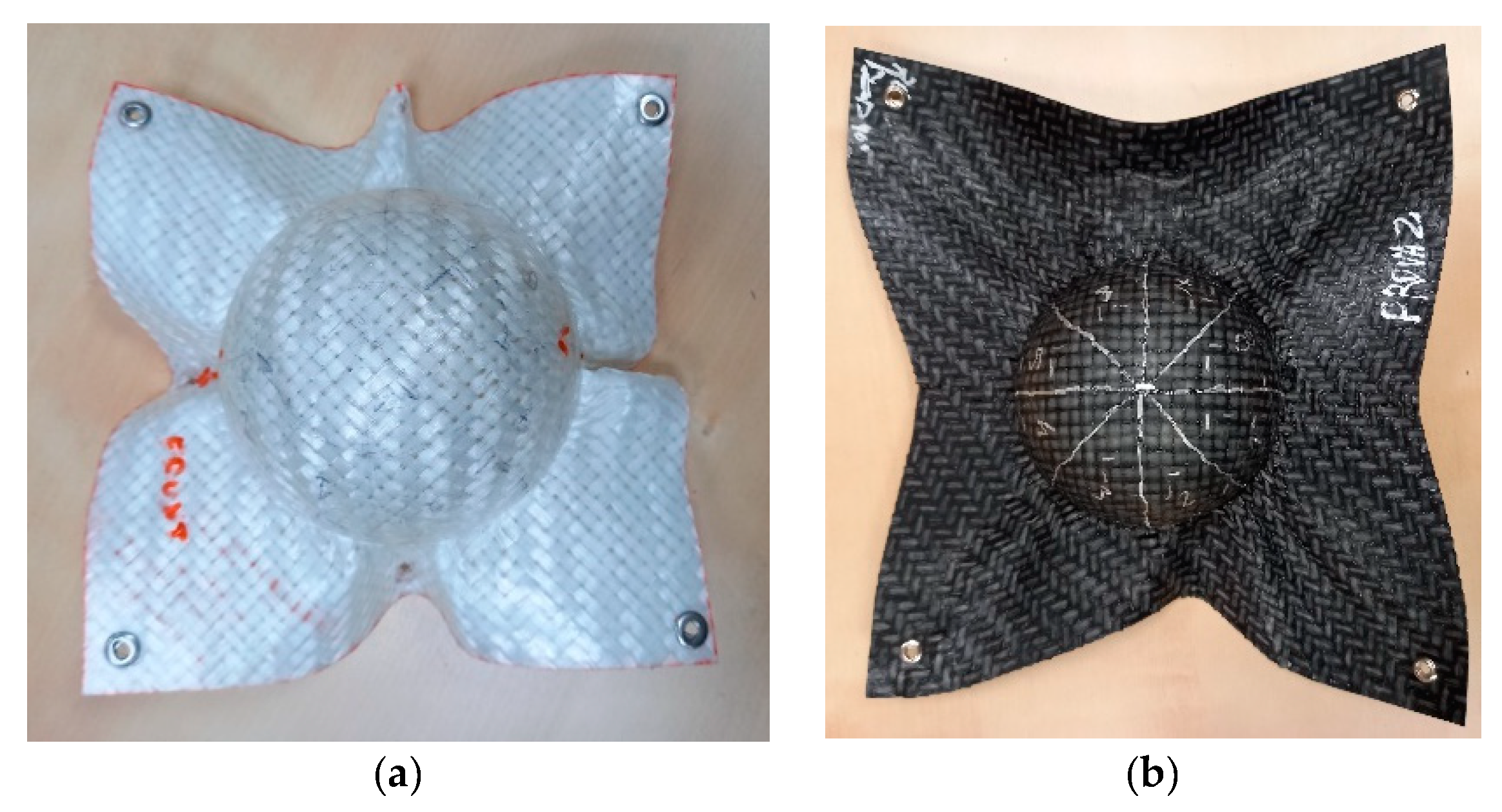

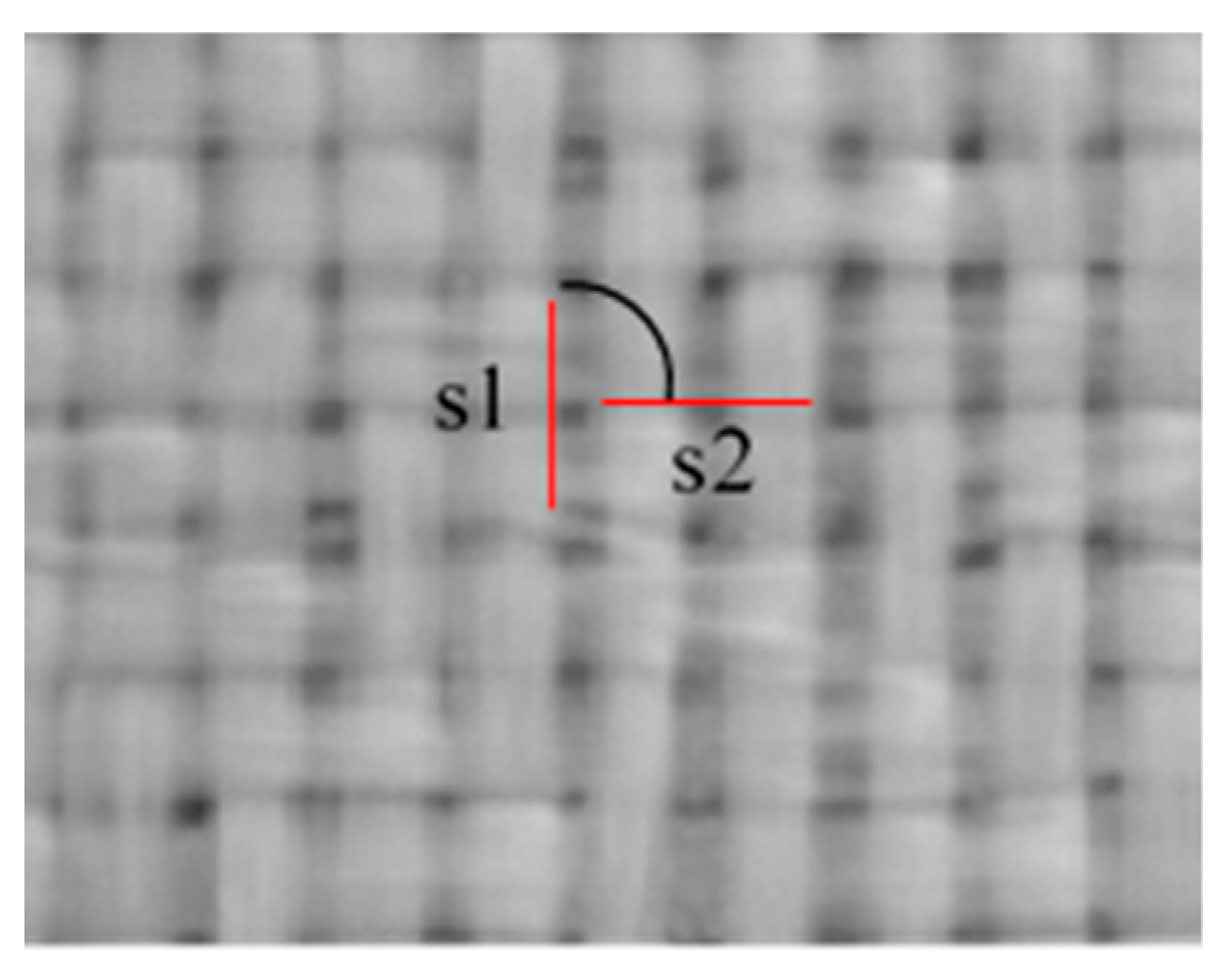
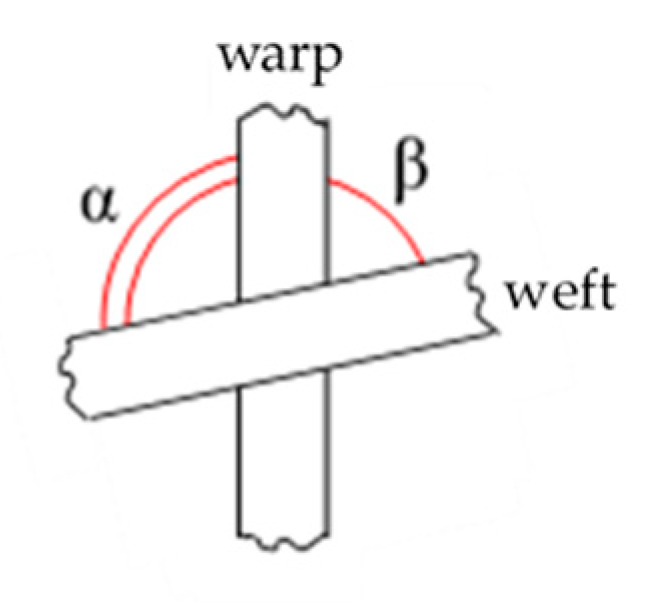
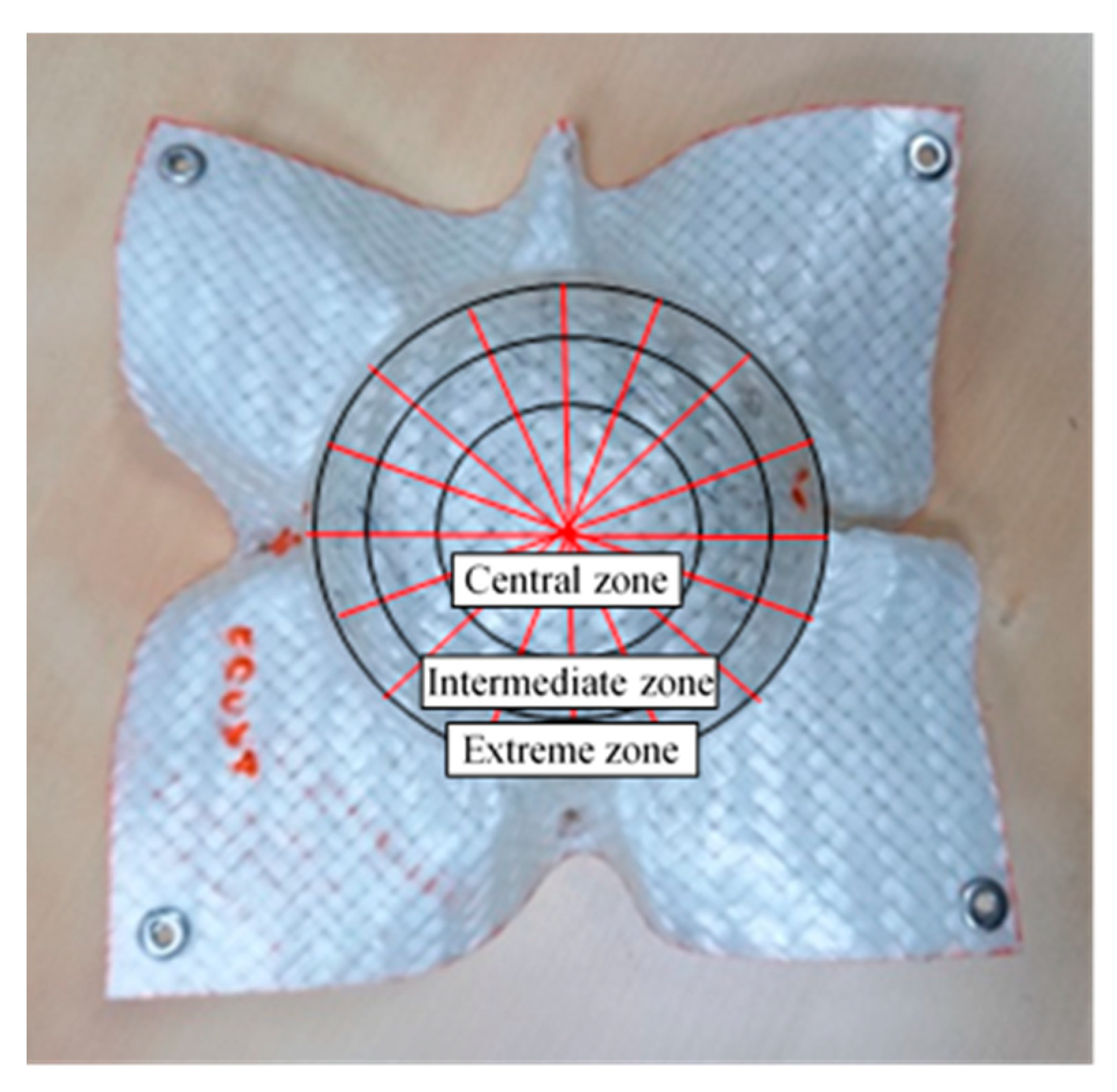


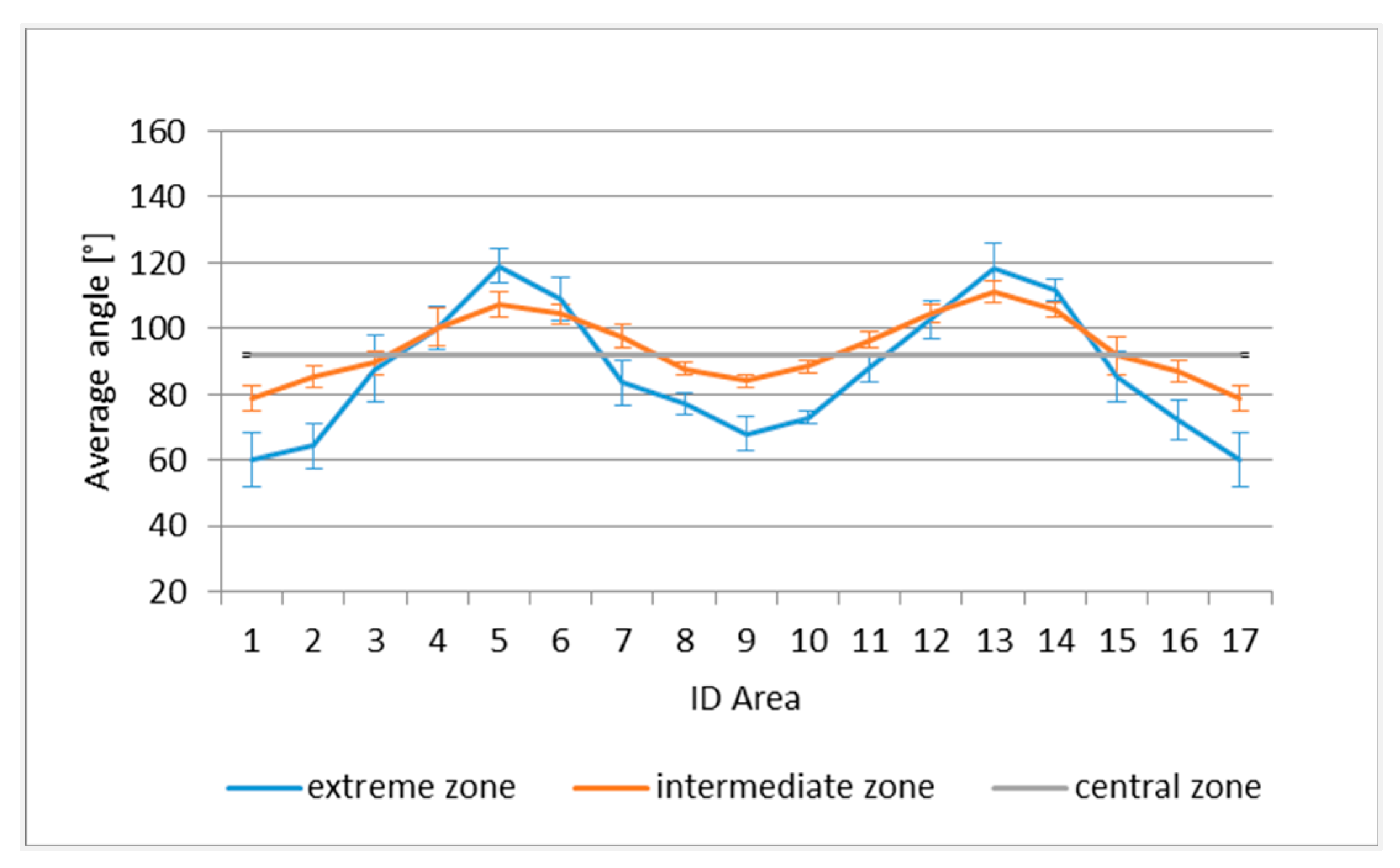

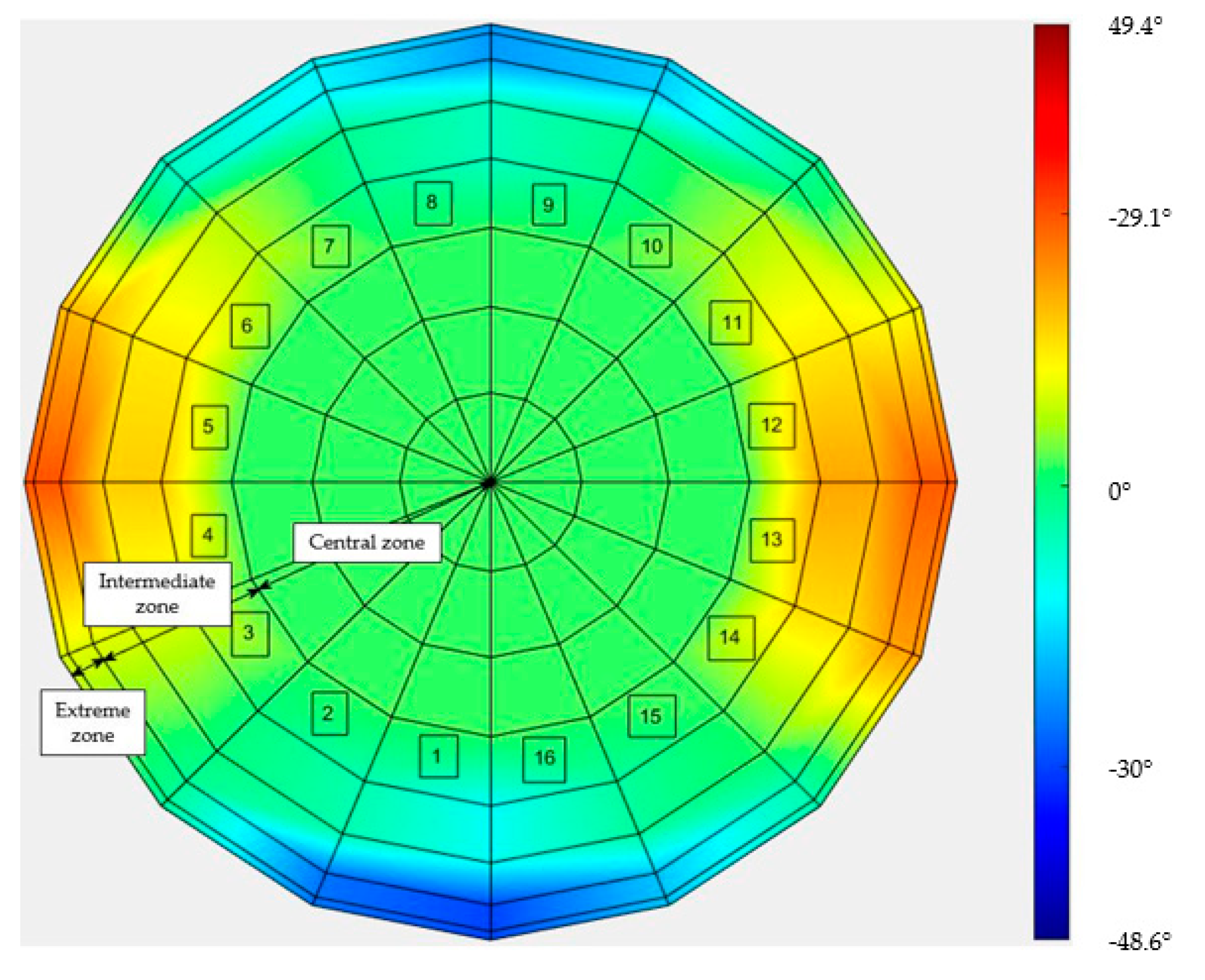


| Material | Variability [°] | Distribution | Factor | Sensitivity Coefficient | Uncertainty Contribution [°] | |
|---|---|---|---|---|---|---|
| Resolution | TRICAP | 0.63 | Rectangular | 1 | 0.36 | |
| TEPEX | 1.2 | Rectangular | 1 | 0.69 | ||
| Method | TRICAP | 1.3 | Gaussian | 1 | 1 | 1.3 |
| TEPEX | 3.3 | Gaussian | 1 | 1 | 3.3 | |
| Measurand | TRICAP | 1.6 | Gaussian | 1 | 1 | 1.6 |
| TEPEX | 2.9 | Gaussian | 1 | 1 | 2.9 | |
| Perspective | Both | 1 | Rectangular | 1 | 0.58 | |
| Parameter set-up | TRICAP | 1.5 | Rectangular | 1 | 0.87 | |
| TEPEX | 0.9 | Rectangular | 1 | 0.52 | ||
| Illumination conditions | Both | 1 | Rectangular | 1 | 0.58 | |
| Overall standard deviation | TRICAP | 2.4° | ||||
| TEPEX | 4.6° | |||||
Publisher’s Note: MDPI stays neutral with regard to jurisdictional claims in published maps and institutional affiliations. |
© 2021 by the authors. Licensee MDPI, Basel, Switzerland. This article is an open access article distributed under the terms and conditions of the Creative Commons Attribution (CC BY) license (https://creativecommons.org/licenses/by/4.0/).
Share and Cite
D’Emilia, G.; Gaspari, A.; Natale, E.; Ubaldi, D. Uncertainty Evaluation in Vision-Based Techniques for the Surface Analysis of Composite Material Components. Sensors 2021, 21, 4875. https://doi.org/10.3390/s21144875
D’Emilia G, Gaspari A, Natale E, Ubaldi D. Uncertainty Evaluation in Vision-Based Techniques for the Surface Analysis of Composite Material Components. Sensors. 2021; 21(14):4875. https://doi.org/10.3390/s21144875
Chicago/Turabian StyleD’Emilia, Giulio, Antonella Gaspari, Emanuela Natale, and Davide Ubaldi. 2021. "Uncertainty Evaluation in Vision-Based Techniques for the Surface Analysis of Composite Material Components" Sensors 21, no. 14: 4875. https://doi.org/10.3390/s21144875







